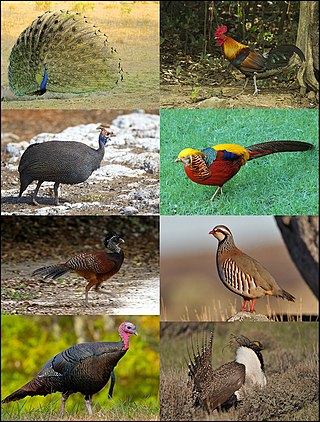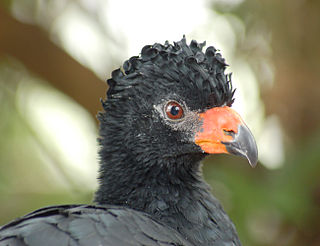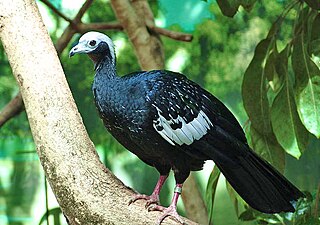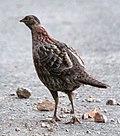
Falcons are birds of prey in the genus Falco, which includes about 40 species. Falcons are widely distributed on all continents of the world except Antarctica, though closely related raptors did occur there in the Eocene.

Pheasants are birds of several genera within the family Phasianidae in the order Galliformes. Although they can be found all over the world in introduced populations, the pheasant genera native range is restricted to Eurasia. The classification "pheasant" is paraphyletic, as birds referred to as pheasants are included within both the subfamilies Phasianinae and Pavoninae, and in many cases are more closely related to smaller phasianids, grouse, and turkey than to other pheasants.

Galliformes is an order of heavy-bodied ground-feeding birds that includes turkeys, chickens, quail, and other landfowl. Gallinaceous birds, as they are called, are important in their ecosystems as seed dispersers and predators, and are often reared by humans for their meat and eggs, or hunted as game birds.

The common pheasant is a bird in the pheasant family (Phasianidae). The genus name comes from Latin phasianus, "pheasant". The species name colchicus is Latin for "of Colchis", a country on the Black Sea where pheasants became known to Europeans. Although Phasianus was previously thought to be closely related to the genus Gallus, the genus of junglefowl and domesticated chickens, recent studies show that they are in different subfamilies, having diverged over 20 million years ago.

The Phasianidae are a family of heavy, ground-living birds, which includes pheasants, partridges, junglefowl, chickens, turkeys, Old World quail, and peafowl. The family includes many of the most popular gamebirds. The family is a large one and includes 185 species divided into 54 genera. It was formerly broken up into two subfamilies, the Phasianinae and the Perdicinae. However, this treatment is now known to be paraphyletic and polyphyletic, respectively, and more recent evidence supports breaking it up into two subfamilies: Rollulinae and Phasianinae, with the latter containing multiple tribes within two clades. The New World quail (Odontophoridae) and guineafowl (Numididae) were formerly sometimes included in this family, but are now typically placed in families of their own; conversely, grouse and turkeys, formerly often treated as distinct families, are now known to be deeply nested within Phasianidae, so they are now included in the present family.

Junglefowl are the only four living species of bird from the genus Gallus in the bird order Galliformes, and occur in parts of South and Southeast Asia. One of the species in this genus, the red junglefowl, is of historical importance as the direct ancestor of the domestic chicken, although the grey junglefowl, Sri Lankan junglefowl and green junglefowl are likely to have also been involved. The Sri Lankan junglefowl is the national bird of Sri Lanka. They diverged from their common ancestor about 4–6 million years ago. Although originating in Asia, remains of junglefowl bones have also been found in regions of Chile, which date back to 1321–1407 CE, providing evidence of possible Polynesian migration through the Pacific Ocean.

Curassows are one of the three major groups of cracid birds. They comprise the largest-bodied species of the cracid family. Three of the four genera are restricted to tropical South America; a single species of Crax ranges north to Mexico. They form a distinct clade which is usually classified as the subfamily Cracinae.

The green pheasant, also known as the Japanese green pheasant, is an omnivorous bird native to the Japanese archipelago, to which it is endemic. Some taxonomic authorities consider it a subspecies of the common pheasant, Phasianus colchicus. It is the national bird of Japan.

The "typical" pheasant genus Phasianus in the family Phasianidae consists of two species. The genus name is Latin for pheasant.

The piping guans are a bird genus, Pipile, in the family Cracidae. A recent study, evaluating mtDNA, osteology and biogeography data concluding that the wattled guan belongs in the same genus as these and is a hypermelanistic piping guan. Thus, Pipile became a junior synonym of Aburria, though this conclusion was not accepted by the South American Checklist Committee, or evaluated by the IOC, so the classification remains in Pipile.

The genus Eligmodontia consists of five or six species of South American sigmodontine mice restricted to Bolivia, Chile, and Argentina. Species of Eligmodontia occur along the eastern side of the Andes Mountains, in Patagonia, and in the Chaco thorn forest of South America. They can be found in arid and semiarid habitats and in both high and low elevation areas. These rodents are commonly known as gerbil mice or by their local name lauchas. Sometimes they are also called silky desert mice, highland desert mice or silky-footed mice. The closest living relatives are probably the chaco mice (Andalgalomys), the leaf-eared mice, and Salinomys.

The Palawan peacock-pheasant is a medium-sized bird in the family Phasianidae endemic to the island of Palawan in the Philippines. It is known as tandikan in the local Palawano, Tagbanwa, and Batak languages of Palawan. It is featured prominently in the culture of the indigenous people of Palawan. The bird is also depicted in the official seal of the city of Puerto Princesa.

The Malayan peacock-pheasant also known as crested peacock-pheasant or Malaysian peacock-pheasant, is a medium-sized pheasant of the galliform family Phasianidae. The closely related Bornean peacock-pheasant was formerly included here as a subspecies, but as understood today, P. malacense is monotypic.

Reeves's pheasant is a large pheasant within the genus Syrmaticus. It is endemic to China. It is named after the British naturalist John Reeves, who first introduced live specimens to Europe in 1831.

The copper pheasant or Soemmerring's pheasant is endemic to Japan. The scientific name commemorates the German scientist Samuel Thomas von Sömmerring.

The bronze-tailed peacock-pheasant is also known as the Sumatran peacock-pheasant. It is an Indonesian bird.

The mountain peacock-pheasant, also known as Rothschild's peacock-pheasant or mirror pheasant, is a medium-sized, up to 65 cm long, blackish brown pheasant with small ocelli and long graduated tail feathers. Both sexes are similar. The male has metallic blue ocelli on upperparts, green ocelli on tail of twenty feathers and two spurs on legs. Female has black ocelli on upperparts, unspurred legs and tail of eighteen feathers. The female is smaller and duller than male.

Germain's peacock-pheasant is a pheasant that is endemic to Indochina. The name commemorates the French colonial army's veterinary surgeon Louis Rodolphe Germain.

The genus Pauxi consists of the three species of helmeted curassows, terrestrial black fowl with ornamental casque on their heads. All are found in South America.

Patagioenas is a genus of New World pigeons whose distinctness from the genus Columba was long disputed but ultimately confirmed. It is basal to the Columba-Streptopelia radiation. Their ancestors diverged from that lineage probably over 8 million years ago. While the biogeographic pattern of this group suggests that the ancestors of the typical pigeons and turtle-doves settled the Old World from the Americas, Patagioenas may just as well be the offspring of Old World pigeons which only radiated into different genera later, given that the cuckoo-doves (Macropygia) of Southeast Asia also seem to be closely related.


































